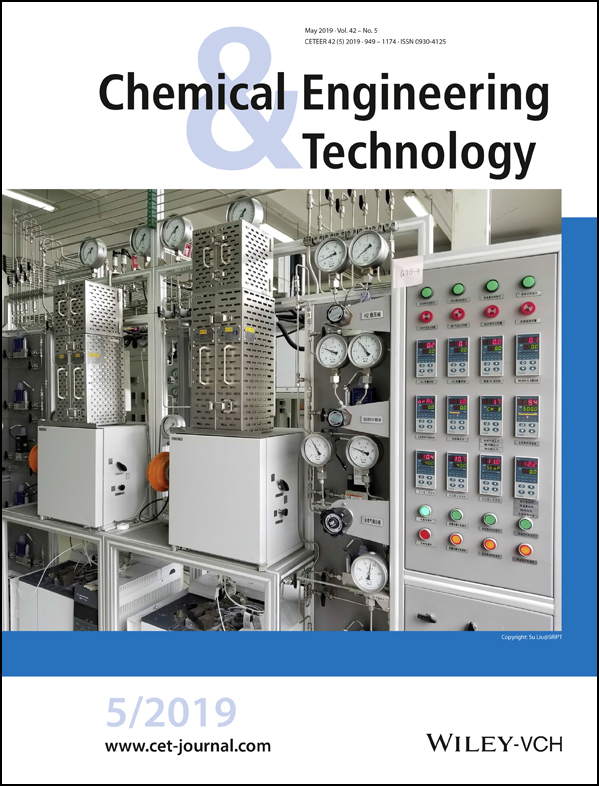Effect of the Co-SiO2 Mesoporous Layer Coating Step on the Performance of Liquid Fuel Dimethyl Amino Ethyl Azide Dehydration
Elham Rahimi
Malek Ashtar University of Technology, Faculty of Chemistry and Chemical Engineering, Shaabanlou street, 16765/34 54 Tehran, Iran
Search for more papers by this authorCorresponding Author
Shahram G. Pakdehi
Malek Ashtar University of Technology, Faculty of Chemistry and Chemical Engineering, Shaabanlou street, 16765/34 54 Tehran, Iran
Correspondence: Shahram G. Pakdehi ([email protected]), Malek Ashtar University of Technology, Faculty of Chemistry and Chemical Engineering, Shaabanlou street, 16765/34 54 Tehran, Iran.Search for more papers by this authorKorosh Shafiei
Malek Ashtar University of Technology, Faculty of Chemistry and Chemical Engineering, Shaabanlou street, 16765/34 54 Tehran, Iran
Search for more papers by this authorElham Rahimi
Malek Ashtar University of Technology, Faculty of Chemistry and Chemical Engineering, Shaabanlou street, 16765/34 54 Tehran, Iran
Search for more papers by this authorCorresponding Author
Shahram G. Pakdehi
Malek Ashtar University of Technology, Faculty of Chemistry and Chemical Engineering, Shaabanlou street, 16765/34 54 Tehran, Iran
Correspondence: Shahram G. Pakdehi ([email protected]), Malek Ashtar University of Technology, Faculty of Chemistry and Chemical Engineering, Shaabanlou street, 16765/34 54 Tehran, Iran.Search for more papers by this authorKorosh Shafiei
Malek Ashtar University of Technology, Faculty of Chemistry and Chemical Engineering, Shaabanlou street, 16765/34 54 Tehran, Iran
Search for more papers by this authorAbstract
A cobalt-doped silica (Co-SiO2) layer was successfully synthesized in a sol-gel process as the mesoporous layer overlaid in three-, six-, and ten-step coating on a mullite support. The microporous layer was coated over the mesoporous layer in six steps by adopting the sol-gel method. The membranes were applied in pervaporation experiments to dehydrate dimethyl amino ethyl azide (DMAZ) containing 5 wt % water. In dehydration tests, the membrane permeate flux decreased and its separation factor increased. During the first initial hours, it reached a steady state and subsequently remained constant.
Supporting Information
| Filename | Description |
|---|---|
| ceat201800359-sup-0001-misc_information.pdf333.4 KB | Supplementary Information |
Please note: The publisher is not responsible for the content or functionality of any supporting information supplied by the authors. Any queries (other than missing content) should be directed to the corresponding author for the article.
References
- 1 Z. Noorpoor, S. G. Pakdehi, A. Rashidi, Adsorption 2017, 23 (5), 743–752. DOI: https://doi.org/10.1007/s10450-017-9892-3
- 2 S. G. Pakdehi, S. Rezaei, H. Motamedoshariati, M. H. Keshavarz, J. Loss Prev. Process Ind. 2004, 29, 277–282. DOI: https://doi.org/10.1016/j.ijlp.2014.03.006
- 3 S. G. Pakdehi, S. Ajdari, A. Hashemi, M. H. Keshavarz, J. Energy Mater. 2015, 33 (1), 17–23. DOI: https://doi.org/10.1080/07370652.2013.877101
- 4 P. Aptel, N. Challard, J. Cuny, J. Neel, J. Membr. Sci. 1976, 1, 271–287. DOI: https://doi.org/10.1016/S0376-7388(00)82272-3
- 5 I. Cabasso, Ind. Eng. Chem. Prod. Res. Dev. 1983, 22 (2), 313–319. DOI: https://doi.org/10.1021/i300010a029
- 6 B. K. Dutta, S. K. Sikdar, AIChE J. 1991, 37 (4), 581–588. DOI: https://doi.org/10.1002/aic.690370411
- 7 H. M. Van Veen, Y. C. Van Delft, C. W. R. Engelen, P. P. A. C. Pex, Sep. Purif. Technol. 2001, 22, 361–366. DOI: https://doi.org/10.1016/S1383-5866(00)00119-2
- 8 P. Kanti, K. Srigowri, J. Madhuri, B. Smitha, S. Sridhar, Sep. Purif. Technol. 2004, 40 (3), 259–266. DOI: https://doi.org/10.1016/j.seppur.2004.03.003
- 9 D. Hua, Y. K. Ong, Y. Wang, T. Yang, T. S. Chung, J. Membr. Sci. 2014, 453, 155–167. DOI: https://doi.org/10.1016/j.memsci.2013.10.059
- 10 R. W. Baker, J. G. Wijmans, Y. Huang, J. Membr. Sci. 2010, 348 (1–2), 346–352. DOI: https://doi.org/10.1016/j.memsci.2009.11.022
- 11 J. Campaniello, C. W. Engelen, W. G. Haije, P. P. Pex, J. F. Vente, Chem. Commun. 2004, 7, 834–835. DOI: https://doi.org/10.1039/B401496K
- 12 X. Feng, R. Y. Huang, Ind. Eng. Chem. Res. 1997, 36 (4), 1048–1066. DOI: https://doi.org/10.1021/ie960189g
- 13 O. Sae-Khow, S. Mitra, J. Chromatogr. A 2010, 1217 (16), 2736–2746. DOI: https://doi.org/10.1016/j.chroma.2009.12.043
- 14 S. P. Badwal, F. T. Ciacchi, Adv. Mater. 2001, 13 (12–13), 993–996. DOI: https://doi.org/10.1002/1521-4095(200107)13:12/13<993::AID-ADMA993>3.0.CO;2–#
- 15 S. Vercauteren, K. Keizer, E. F. Vansant, J. Luyten, R. Leysen, J. Porous Mater. 1998, 5 (3–4), 241–258. DOI: https://doi.org/10.1023/A:1009634305315
- 16 R. W. Van Gemert, F. P. Cuperus, J. Membr. Sci. 1995, 105 (3), 287–291. DOI: https://doi.org/10.1016/0376-7388(95)00098-W
- 17 S. L. Wee, C. T. Tye, S. Bhatia, Sep. Purif. Technol. 2010, 71 (2), 192–199. DOI: https://doi.org/10.1016/j.seppur.2009.11.021
- 18 S. Xia, X. Dong, Y. Zhu, W. Wei, F. Xiangli, W. Jin, Sep. Purif. Technol. 2011, 77 (1), 53–9. DOI: https://doi.org/10.1016/j.seppur.2010.11.019
- 19 T. Gallego-Lizon, E. Edwards, G. Lobiundo, L. F. Dos Santos, J. Membr. Sci. 2002, 197 (1–2), 309–319. DOI: https://doi.org/10.1016/S0376-7388(01)00650-0
- 20 P. Boutikos, C. S. Pereira, V. M. Silva, A. E. Rodrigues, Sep. Purif. Technol. 2014, 127, 18–28. DOI: https://doi.org/10.1016/j.seppur.2014.02.019
- 21 M. Asaeda, J. Yang, Y. Sakou, J. Chem. Eng. Jpn. 2002, 35 (4), 365–371. DOI: https://doi.org/10.1252/jcej.35.365
- 22
K. Li, Ceramic Membranes for Separation and Reaction, 3rd ed., John Wiley & Sons, West Sussex
2007.
10.1002/9780470319475 Google Scholar
- 23 T. Tsuru, J. Sol-Gel Sci. Technol. 2008, 46 (3), 349–361. DOI: https://doi.org/10.1007/s10971-008-1712-5
- 24 A. W. Verkerk, P. Van Male, M. A. Vorstman, J. T. Keurentjes, Sep. Purif. Technol. 2001, 22, 689–695. DOI: https://doi.org/10.1016/S1383-5866(00)00185-4
- 25 J. Wang, T. Tsuru, J. Membr. Sci. 2011, 369 (1–2), 13–19. DOI: https://doi.org/10.1016/j.memsci.2010.10.062
- 26 E. Johan, C. R. Abadal, J. Sekulić, S. R. Chowdhury, D. H. Blank, Microporous Mesoporous Mater. 2003, 65 (2–3), 197–208. DOI: https://doi.org/10.1016/j.micromeso.2003.08.010
- 27 S. Battersby, S. Smart, B. Ladewig, S. Liu, M. C. Duke, V. Rudolph, J. C. da Costa, Sep. Purif. Technol. 2009, 66 (2), 299–305. DOI: https://doi.org/10.1016/j.seppur.2008.12.020
- 28 R. Igi, T. Yoshioka, Y. H. Ikuhara, Y. Iwamoto, T. Tsuru, J. Am. Ceram. Soc. 2008, 91 (9), 2975–2981. DOI: https://doi.org/10.1111/j.1551-2916.2008.02563.x
- 29 Y. S. Lin, I. Kumakiri, B. N. Nair, H. Alsyouri, Sep. Purif. Methods 2002, 31 (2), 229–379. DOI: https://doi.org/10.1081/SPM-120017009.




